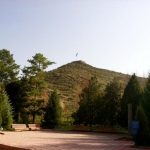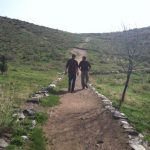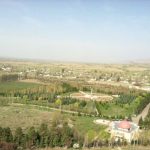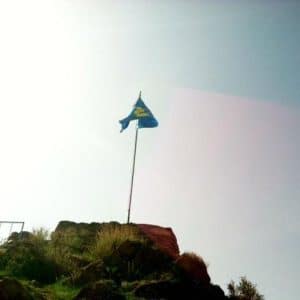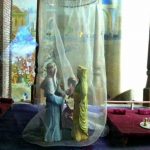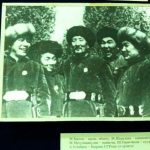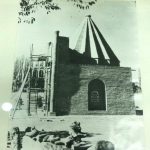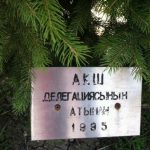Manas Ordo
Address: 10km east of Talas, at the foot of the Manastyn-Chokusu Mountain, on the bank of the Kenkol mountain river
Price: Adults – 20 som; Children – 5 som, Guided Tour – 300 som
Hours: 9:00am-7:00pm
There are few essential things to know about Kyrgyzstan. One of these is the country’s folkloric hero, Manas. You might recognize the name from the Manas Transit Center, the supply center for US troops fighting in Afghanistan. That transit center is named for him, as are quite a lot of things in Kyrgyzstan.
Manas is Kyrgyzstan’s literary, spiritual, and national figure. He is a man known for courageously fighting against external foes and reuniting the 12 tribes of the Kyrgyz people. He is also the ultimate symbol of Kyrgyz cultural identity, which is expressed all over Bishkek, from his looming statue in Bishkek’s central square, to his image plastered on Coca Cola billboards. Just how big a hero are we talking about? Put it this way. The Manas epic poem, which has more than 80 versions and has been translated to more than 39 languages, is the longest epic poem in the world. At close to half a million lines, it is 20 times longer than the Odyssey and the Illiad combined. Welcome to Kyrgyzstan; Welcome to the Land of Manas.
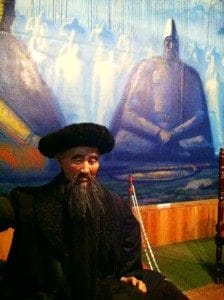
Now, like that of Odysseus, Hercules, or Paul Bunyan, the true existence of Manas is not entirely certain. Like most myths, stories of him were probably originally based on fact, then got elevated to larger-than-life, legendary status after a centuries of storytelling by the manaschi, the Krygyz bards who dedicated themselves to memorizing the lines and chanting the verses of his story. This long game of “Manas Telephone” likely began in the 16th century (which, according to traditionalists, was well after the man himself was dead) before Russian ethnographers in the 19th century actually wrote it all down. But real or not, Manas defines the Kyrgyz spirit. Today, Kyrgyz people still say to each other, “I wish the soul of Manas to protect you” when they want to wish each other well.
I therefore invite you to visit Kyrgyzstan’s main Manas pilgrimage site, Manas Ordo, about five hours west of Bishkek in Talas Valley. We visited as part of our regular excursion packages offered by SRAS and The London School as part of their Russian as a Second Language and Central Asian Studies programs. There, you will find a complex dedicated to Manas’ legacy, including his (supposed) tomb, a watchtower, cemetery, hippodrome, rose garden surrounded by statues of Manas’ 40 soldiers, a museum, and spruce trees donated by current and past Kyrgyz Presidents, as well as visiting foreign delegations. Spruce trees are ubiquitous in the Tian Shan Mountains. The complex was built in 1995, when Kyrgyzstan celebrated the 1,000-year anniversary of the Manas epic poem. To date, this celebration was Kyrgyzstan’s largest national celebration since independence.
If you are interested, there is a much more extensive article on Manas and his cultural heritage on the SRAS main site.

The biggest draw of the complex is Manas’ tomb, or gumbez, as it is known in Kyrgyz. Built in the 1334, by order of his wife, Kanikei, the tomb is a simple architectural brick beauty. Supposedly, Kanikei had the engraver inscribe words on the tomb saying that it was a mausoleum for a young girl to deter potential looters. The tomb is also popular because of its surrounding gardens and benches, which allow visitors to pray, reflect, read from their Quran, or just enjoy a time of quiet and tranquility. Indeed, the peaceful locale is so optimal that some locals pay a visit to the tomb at least once a week, if not for Islamic purposes, then definitely for its spiritual purposes. (And after seeing many Muslims hold up their hands in prayer, close their eyes, and then rub their face with a look of content and deep satisfaction, it is easy to understand why.)
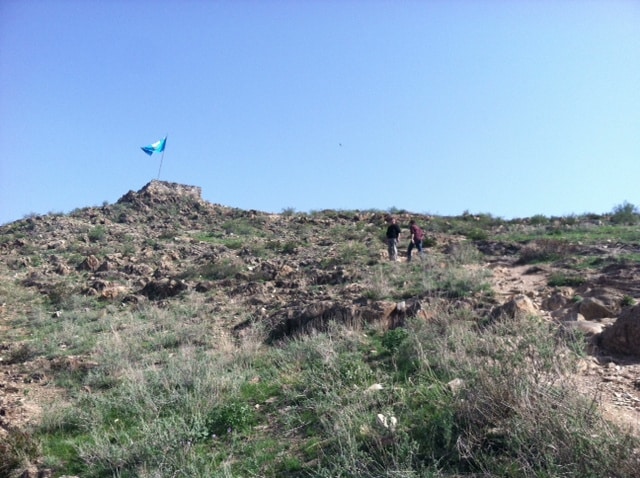
Manas Ordo is also popular for its mountain watchtower, Karool choku, which takes about 15 minutes to climb. At the top is a bright blue flag (with an image of Manas on top of a horse), and benches for more prayer, reflection, and enjoyment of Talas Valley’s stunning natural landscape. From its vantage, you can also see the rest of the complex, as well as roving sheep and goats on the mountains, an eerie amount of squawking ravens (why there are so many ravens there, no one could explain to me), and strolling wedding parties that come for wedding photos. Indeed, Manas Ordo is a popular photo destination, and in the summer and fall there are as many as three or four wedding parties at any given time.
Finally, Manas Ordo is a popular for its comprehensive historical museum. There, the story of Manas is brought to life through colorful dioramas, clothing items, horse accessories, and knowledgeable guides who can speak English and translate the Kyrgyz and Russian exhibitions. The most interesting exhibits for me were the ones about the manaschi, those who can recite the Manas epic from memory while adding their own improvisational style and musical rhythm. As I saw the black-and-white photographs and wax sculptures of famous manaschi devoting their lives to reciting the story of this mythological character, I appreciated Manas even more. He was more than a man, but a cultural muse who is still inspiring real people generations later to create unique artistic traditions and rituals. He also inspired people to act almost religiously. People would not only engage in the act of “praying” to him for help, assistance, and protection, but would also imitate styles of prayer. For instance, when I heard that the most famous manaschi, Sayakbai Karalayev, recited the Manas epic for 24 hours without stopping, I thought of Sufi whirling dervishes, who would whirl and whirl and whirl in trance-like meditation. How beautiful it must have been to witness these manaschi whirl the words of the Kyrgyz language with such grace and ferocity.
So, for me, the Manas legend and legacy is fascinating and dynamic. I’d be curious to see how the Manas “brand” — or as some would call it, Manas “mania” — develops as the Kyrgyz government continues to develop its post-Soviet, post-Russian cultural identity. Or maybe the Manas “mania” will soon saturate. Whatever happens, I encourage you to join in the current fervor by driving out to Talas Valley and paying a visit to Manas Ordo. Being amidst the snow-covered Ala-Too mountains, reflective pilgrims, curious tourists, and architectural beauty of Manas-inspired monuments, you will feel all the richer, both intellectually and spiritually.



